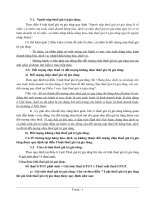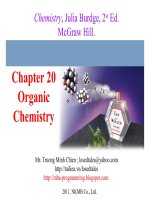BÀI GIẢNG ORGANIC CHEMISTRY chapter9
Bạn đang xem bản rút gọn của tài liệu. Xem và tải ngay bản đầy đủ của tài liệu tại đây (497.79 KB, 52 trang )
ORGANIC CHEMISTRY
Dr Nam T. S. Phan
Faculty of Chemical Engineering
HCMC University of Technology
Office: room 211, B2 Building
Phone: 38647256 ext. 5681
Email:
1
Chapter 9:
ALKYL HALIDES
2
NOMENCLATURE OF ALKYL
HALIDES
Common names: alkylhalide (chloride, bromide…)
IUPAC names: halogeno + alkane (chloro, bromo…)
3
Alkyl & halogen substituents are considered of
equal rank
4
PREPARATION OF ALKYL HALIDES
Alkyl halides from alcohols
Only in acidic conditions
5
Alkyl halides from alkenes
More stable
6
Alkyl halides from alkanes
Chlorination is much less selective
7
REACTIONS OF ALKYL HALIDES
Very
reactive
Very
unreactive
With the same R
8
NUCLEOPHILIC SUBSTITUTION
REACTIONS
SN1 vs SN2 – depending on alkyl structure,
nucleophile concentration & reactivity, and solvent
9
Stereochemistry of SN2 reactions
• The nucleophile attacks from the back side / the side
directly opposite the leaving group
• This attacks causes an inversion of configuration
10
11
Stereochemistry of SN1 reactions
12
However, few SN1 reactions occur with
complete racemization
13
Factors affecting the rates of
SN1 & SN2
1. The structure of the substrate
2. The concentration & reactivity of
the nucleophile
3. The reaction solvent
4. The nature of the leaving group
14
Affects of substrate structure
Steric
hindrance
Steric effect in the SN2 reaction
15
16
17
18
Affects of nucleophile concentration
& strength
1) Neither the concentration nor the
structure of the nucleophile affects the
rates of SN1 reactions since the
nucleophile does not participate in the
rate-determining step
2) The rates of SN2 reactions depend on
both the concentration and the structure
of the nucleophile
19
20
Nucleophiles that have the same attacking atom:
nucleophilicity roughly parallels basicity:
21
ROH, HOH
22
Affects of solvents on SN2
• In polar aprotic solvent, nuceophilicity parallels basicity
Polar aprotic solvents solvate cation but not anions
Rates of SN2 reactions are generally increased in
polar aprotic solvent
23
24
Affects of solvents on SN1
Polar protic solvents solvate cation & anions effectively
Rates of SN1 reactions are generally increased in
polar protic solvent
25









